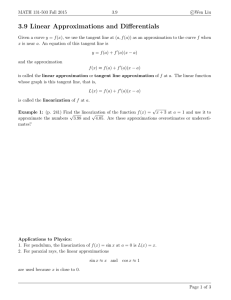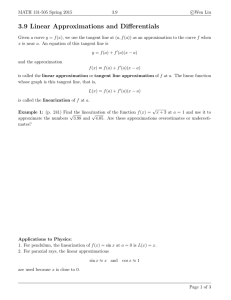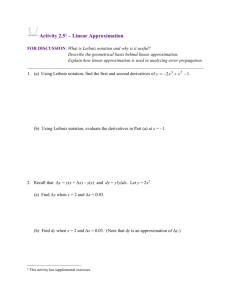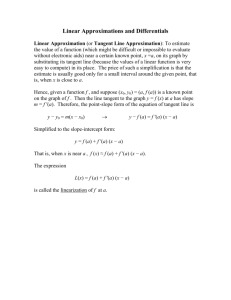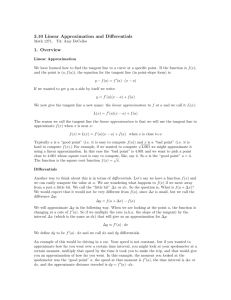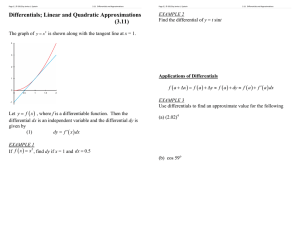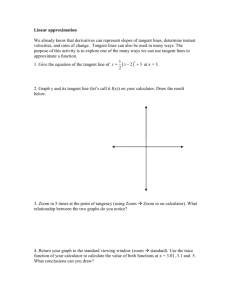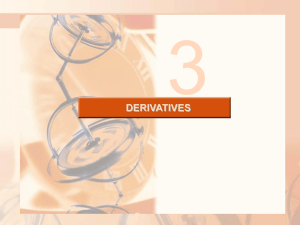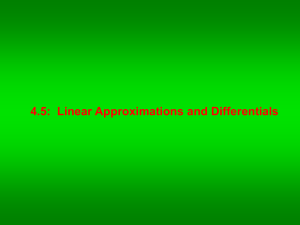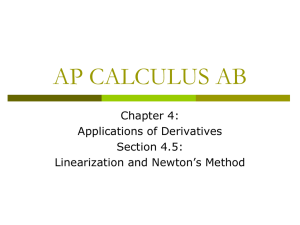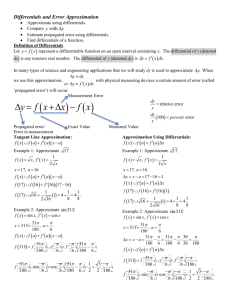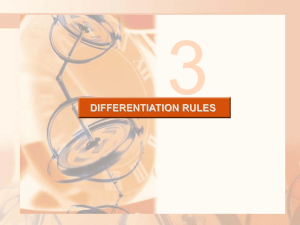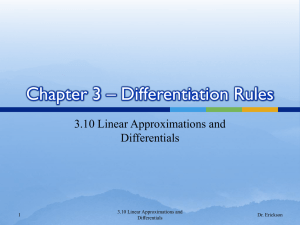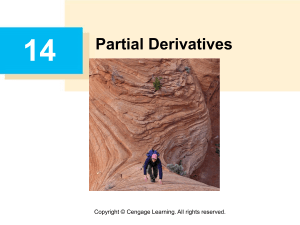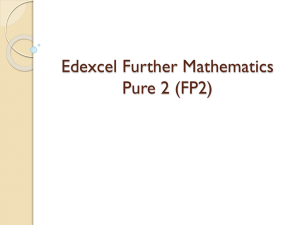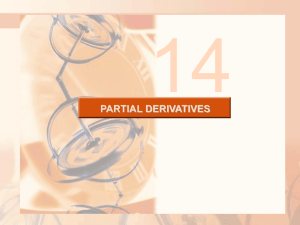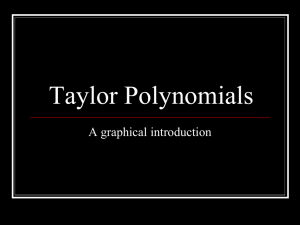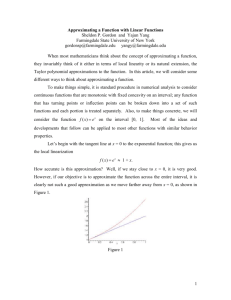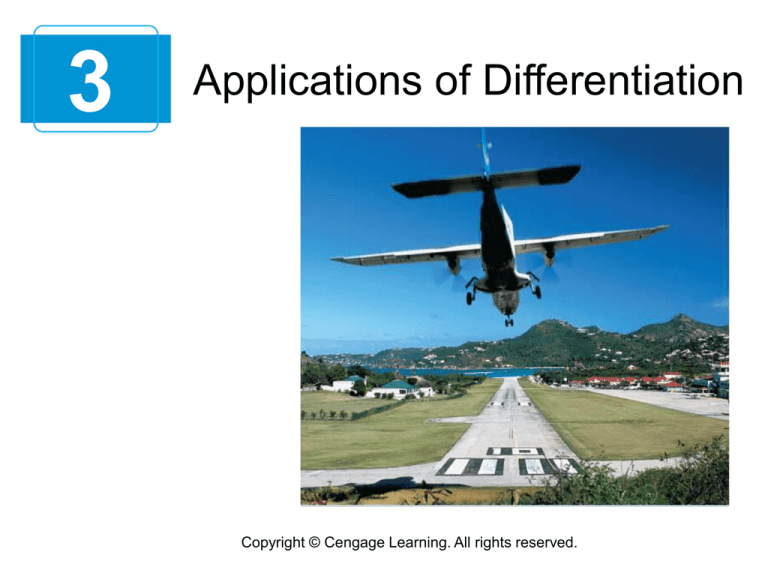
3
Applications of Differentiation
Copyright © Cengage Learning. All rights reserved.
3.9
Differentials
Copyright © Cengage Learning. All rights reserved.
Objectives
Understand the concept of a tangent line
approximation.
Compare the value of the differential, dy, with
the actual change in y, Δy.
Estimate a propagated error using a differential.
Find the differential of a function using
differentiation formulas.
3
Tangent Line Approximations
4
Tangent Line Approximations
Consider a function f that is differentiable at c. The
equation for the tangent line at the point (c, f(c)) is given by
y – f(c) = f'(c)(x – c)
and is called the tangent line approximation (or linear
approximation) of f at c.
Because c is a constant, y is a linear function of x.
5
Example 1 – Using a Tangent Line Approximation
Find the tangent line approximation of
f(x) = 1 + sin x
at the point (0, 1).Then use a table to compare the y-values
of the linear function with those of f(x) on an open interval
containing x = 0.
Solution:
The derivative of f is
f'(x) = cos x.
First derivative
6
Example 1 – Solution
cont'd
So, the equation of the tangent line to the graph of f at the
point (0, 1) is
y – f(0) = f'(0)(x – 0)
y – 1 = (1)(x – 0)
y = 1 + x.
7
Example 1 – Solution
cont'd
The table compares the values of y given by this linear
approximation with the values of f(x) near x = 0.
Notice that the closer x is to 0, the better the approximation is.
8
Example 1 – Solution
cont'd
This conclusion is reinforced by the graph shown in
Figure 3.65.
Figure 3.65
9
Differentials
10
Differentials
When the tangent line to the graph of f at the point (c, f(c))
y = f(c) + f'(c)(x – c)
is used as an approximation of
the graph of f, the quantity
x – c is called the change in x,
and is denoted by Δx,
as shown in Figure 3.66.
Figure 3.66
11
Differentials
When Δx is small, the change in y (denoted by Δy) can be
approximated as shown.
Δy = f(c + Δx) – f(c)
≈ f'(c)Δx
For such an approximation, the quantity Δx is traditionally
denoted by dx, and is called the differential of x.
The expression f'(x)dx is denoted by dy, and is called the
differential of y.
12
Differentials
13
Example 2 – Comparing Δy and dy
Let y = x2. Find dy when x = 1 and dx = 0.01.
Compare this value with Δy for x = 1 and Δx = 0.01.
Solution:
Because y = f(x) = x2, you have f'(x) = 2x, and the
differential dy is given by
dy = f'(x)dx = f'(1)(0.01) = 2(0.01) = 0.02.
Now, using Δx = 0.01, the change in y is
Δy = f(x + Δx) – f(x) = f(1.01) – f(1)
= (1.01)2 – 12 = 0.0201.
14
Example 2 – Solution
cont'd
Figure 3.67 shows the geometric comparison of dy and Δy.
Figure 3.67
15
Error Propagation
16
Error Propagation
If you let x represent the measured value of a variable and
let x + Δx represent the exact value, then Δx is the error in
measurement.
Finally, if the measured value x is used to compute another
value f(x), the difference between f(x +Δx) and f(x) is the
propagated error.
17
Example 3 – Estimation of Error
The measured radius of a ball bearing is 0.7 inch, as
shown in Figure 3.68. If the measurement is correct to
within 0.01 inch, estimate the propagated error in the
volume V of the ball bearing.
Figure 3.68
18
Example 3 – Solution
The formula for the volume of a sphere is
where r is the radius of the sphere.
,
So, you can write
and
To approximate the propagated error in the volume,
differentiate V to obtain
and write
19
Example 3 – Solution
So, the volume has a propagated error of about 0.06 cubic
inch.
20
Error Propagation
The ratio
is called the relative error. The corresponding percent
error is approximately 4.29%.
21
Calculating Differentials
22
Calculating Differentials
Each of the differentiation rules can be written in
differential form.
23
Example 4 – Finding Differentials
The notation in Example 4 is called the Leibniz notation
for derivatives and differentials, named after the German
mathematician Gottfried Wilhelm Leibniz.
24
Calculating Differentials
Differentials can be used to approximate function values.
To do this for the function given by y = f(x), use the formula
which is derived from the approximation
Δy = f(x + Δx) – f(x) ≈ dy.
The key to using this formula is to choose a value for x that
makes the calculations easier.
25
Example 7 – Approximating Function Values
Use differentials to approximate
Solution:
Using
you can write
Now, choosing x = 16 and dx = 0.5, you obtain the following
approximation.
26
Example 7 – Solution
The tangent line approximation to
line
cont'd
at x = 16 is the
For x-values near 16, the graphs of f and g are close
together, as shown in Figure 3.69.
Figure 3.69
27

